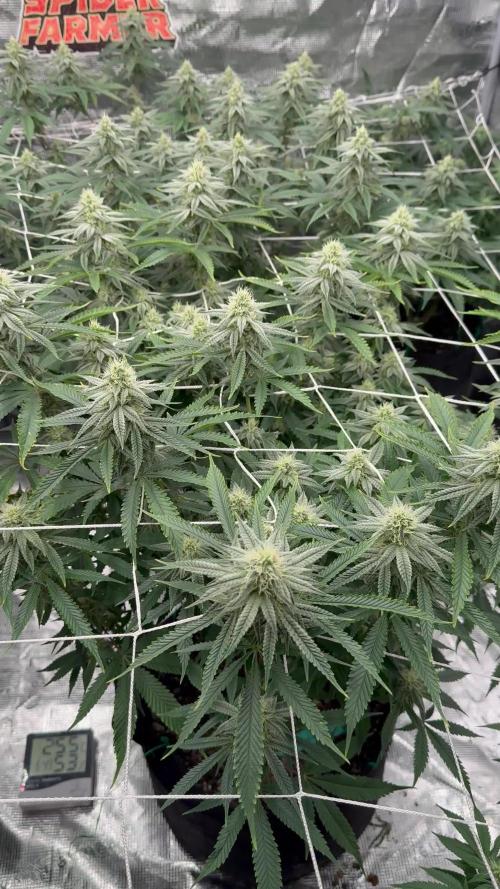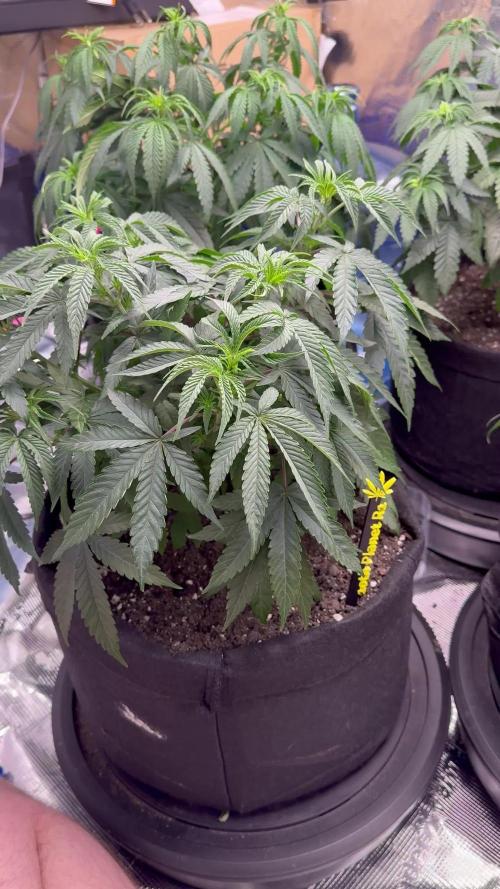The Grow Awards 2026 🏆 





































Likes
Comments
Share


@Nony_grows
Follow
I have a cal mag deficiency I’ve already treated it. We are on cruise control at this point, just waiting in the finish line.
Likes
2
Share


@Calyxico
Follow
Kiki gets her flowers. Increasing the watering frequency (note the "w" on her schedule) as she started to wilt on day 4. In theory, she only has two weeks left, but I think she may use the extea time to bulk up. thw color is starting to fade on the fan leaves close to the flowers. I am also doing a partial defoliation everyday.
Processing
Likes
4
Share


@UK420hydrogrow
Follow
Had a bit of a bad week with the girls in flower tent also had few issues with the ph @6.3 been to high causing a few problems had to defoliate all affected leaves hopefully they will bounce back
Likes
3
Share


@S3phwaa
Follow
Working on some timelapse settings so I can have some cool development videos for my journals. Enjoy!
Does the size/height and thickness of these guys seem healthy for the 6 week age? Just want to check in with some experienced growers.
Likes
Comments
Share


@Growshh
Follow
Defoliated on day 19 and 20. One of the Blueberry Cherry had a bunch of nanas on the lowers only, but it's not a full herms. So I left it to monitor. Only one or 2 on some others but on the lowers.
The scent is lacking tbh but let's see how it progresses.
Switched back to top dress organics and water in brix and aminos.
Likes
37
Share


@Coolhlmeds
Follow
12/23/17 Getting anxious for sure... Not idea how much longer these will go... getting stanky for sure... I didn't move the other one, getting too gnarly to handle too much... Inspect in the tent... Flush soon?!?!? Please let me know what your thoughts are... any... Thanks! Merry x-mas!.
12/29/17 Starting to cloud a bit...
Likes
17
Share


@YorkshireGardeneruk
Follow
They popped up 2nd of January after germination. Biobizz soils mixed just using oxy plus for first couple of weeks as well as silicone
Likes
13
Share


@Growyourownathome2x2
Follow
16th of April day 37 some defoliation done to open up the inner nodes let them get some more light to grow up
Likes
8
Share


@BusyBeeFarmer
Follow
Progress Update:
The Blue Dream plant continues to show excellent development and has handled the increased nutrient levels exceptionally well. It seems less sensitive to feeding adjustments than expected, a positive trait for consistent growth.
Watering Schedule:
Skipped watering this week due to high humidity levels, which kept the soil moist since the last watering at the end of the previous week.
Plant Morphology:
Stem Growth: Strong and stable, indicating excellent structural integrity for supporting future buds.
Internodes: Relatively short, leading to a compact structure—a trait uncommon for Blue Dream and suggestive of a strong Indica influence in this phenotype.
Foliage: The leaves exhibit classic Indica characteristics, with broad, dark green blades.
Observations:
The plant’s Indica-dominant appearance is surprising given Blue Dream’s typical Sativa-dominant profile. This could lead to unique results in both growth patterns and flowering characteristics.
Next Steps:
Maintain consistent environmental conditions and monitor for signs of water requirements next week.
Continue full nutrient feeding while observing for any changes in plant response.
Consider early training techniques if needed to balance compact growth.
This plant’s performance remains impressive, and its unexpected traits make it a fascinating grow to observe. 🌿
dein-onlineheadshop.de/
Use my referral code 420Shop at checkout to get a discount on your purchase. By using this code, you also support me, as I receive a small reward for each use. Thank you for your support!
Likes
29
Share


@Greenthumbguru
Follow
She's doing fine I'ma push for one more week only plain phd water I want them amber trichs I'm dreading trimming she's foxtailin other than that well on my way to my second harvest
Likes
17
Share


@Naujas
Follow
To tell the truth, I am very surprised myself, how amazing she is FastBuds Gorilla cookies, she copes well with a small space:) she drinks 1 liter every day :) everything looks better than expected:) good luck to everyone.
Likes
41
Share


@MadeInGermany
Follow
Welcome to Sweet Seeds Cup 🏆
Hey everyone :-)
This week she has grown very nicely 😊.
It increases very quickly and beautifully.
Today she got the last time the organic vega fertilizer, since the lighting was switched to 12/12 about 6-8 days ago and started to produce her flowers.
The next dose is the first dose of Canna Bio Bloom ☺️.
Tomorrow I will take 2 - 3 shoots down from the bottom, that the full production goes to the thick buds above and will not be wasted on small popcorn buds at the bottom 😍🤗.
Next weekend the next update follows as usual 👍.
I wish you all a good start into the new week 👌, stay healthy 🙏🏻 and let it grow 😎🌱.
Sweet Seeds Cup 🏆
Type:
San Fernando Lemon Kush
☝️🏼
Genetics:
OG Kush x Kosher Kush
👍
Vega lamp: 2 x Todogrow Led
Quantum Board 100 W
💡
Bloom Lamp : 2 x Todogrow Led
Cxb 3590 COB 3500 K 220 W
💡💡☝️🏼
Earth: Canna Bio
☝️🏼
Fertilizer: Canna Bio
☝️🏼🌱
Water: Osmosis water mixed with normal water (24 hours stale that the chlorine evaporates) to 0.2 EC. Add Cal / Mag to 0.4 Ec Ph with Organic Ph - to 6.0 - 6.3
💦💧
Likes
8
Share


@sativa_thc
Follow
esta semana hay ido mejor aun con unos saltamontes por ahi q habian aparecido y pulgones que ya soluciones facilmente con bag x5 y bang x3 de cannaboom la temperatura del tiempo aun gace calor y el frio no llega
Likes
10
Share


@soloczek
Follow
Smells incredible
Blue Zushi very dense and Long buds. Dry harvest 80g
Naranja Biscotti smells like danish buttercookies with oranges
Processing
Likes
6
Share


@Gordy
Follow
Bloom week 1:
I don’t really have too many pictures of this plant in veg. I didn’t plan to bloom her, but after some training she just looked pretty good. This plant is huge compared to my other 2. She’s about 6 months old.
I’ve only fed this plant about 3 times. I fed her yesterday for the first time in probably about 2 months. The plant looks good considering I’ve give her such little love. Hopefully with regular feeding she will blow up… but not too big for my tent I hope.
Processing
Likes
4
Share


@Squaregrouper
Follow
Red dragon had a fruitful week with the extreme temperatures around the hundred range with heat index over a hundred twenty degrees Fahrenheit.. I really like this plant reminds me of the old sativas..
Likes
12
Share


@Microsemilla
Follow
Estas tomas fueron hechas el 19 de Febrero de este 2022.
Es dificil determinar el inicio de la flora en exterior, pero estamos en el dia 122 desde germinadas. Empiezan a encogollar los fenos mas indicones.
Se volvió a podar bajos y se rego con Top Bloom + Top Candy
El mes con menos calor que enero con temperaturas entorno a los 30° Celsius como máximos. Aumento ligero de las precipitaciones.
ig: @micro.semilla
Likes
16
Share


@Chubbs
Follow
420FASTBUDS
FBT2107 WEEK 8
The two of these girls are growing amazing. One definitely is much larger than the other but both appear happy & healthy. I decided to do some LST training on them to allow more light to the lower flower sites. So far it looks like they're enjoying it and bounced back without skipping a beat. I did back off on the feeding of nutes since I started seeing crispy edges on my leafs and since then doesn't look lime it's got worse so back on track. Happy Growing
Processing
Likes
3
Share


@GladaMinnen
Follow
Green gelato is an awesome strain that keeps evolving. A real pleasure for the eye to see. Royal gorilla isnt showing so much progress.. going a bit slow. Is like half the progress of Gelato. And they have exactly same conditions.
Going to start using more supplements at the start of next week.
Was hoping to veg only 4 weeks, nut feelslike ii will have to double atleast.






















